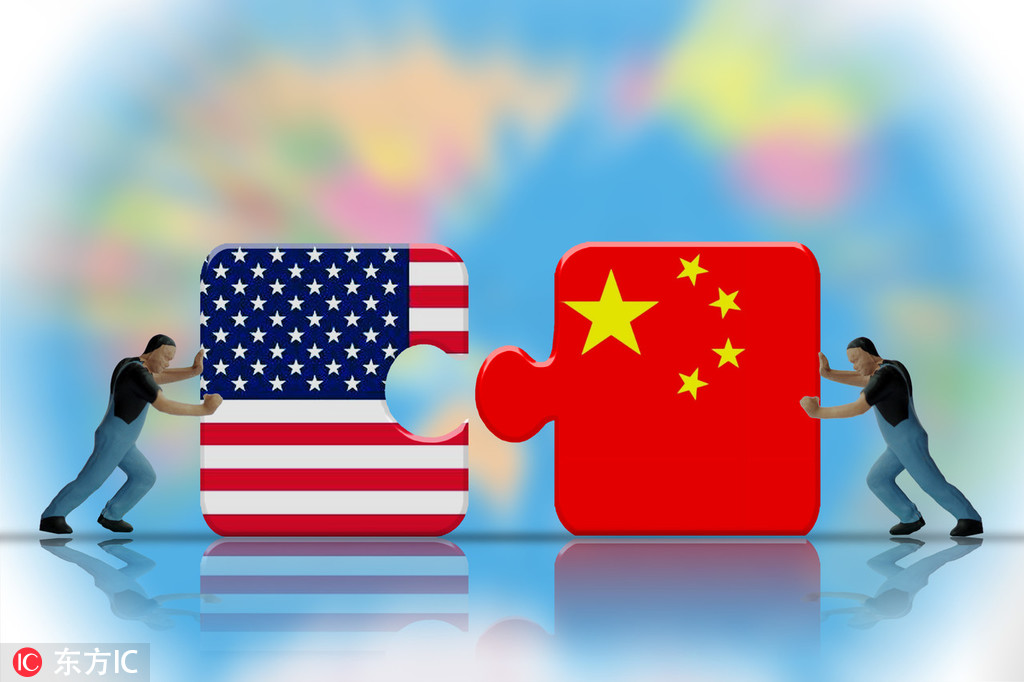Experts' takes on China-US relations - 2023-11-21
Editor's note: The foundation for China-US relations is laid by their people. The fundamental principles guiding China-US relations are mutual respect, peaceful coexistence and win-win cooperation, and the two countries have broad common interests in a wide range of areas, including traditional and emerging areas such as the economy, trade, agriculture and climate change. Three experts offer their insights to China Daily.

A strong boost to China-US trade relationship
By He Weiwen
The historic meeting between President Xi Jinping and US President Joe Biden on Nov 15 signifies the stabilization and improvement in bilateral ties between two of the world's largest economies, something that is crucial for peace and stability in the world.
The two presidents stressed the importance of the two countries treating each other with respect and finding a way to coexist peacefully, and keeping the lines of communication, preventing conflict, upholding the United Nations Charter, cooperating on areas of shared interest and responsibly managing the competitive aspects of the relationship.
The significant, positive outcome of the Filoli Estate summit meeting will undoubtedly provide a strong, much-needed boost to China-US bilateral trade relations which have been largely affected by the overall tensions in recent years. From January to October this year, Chinese exports to the US fell by 15.3 percent over a year ago. The US official trade data show that during Q1-3 of 2023, its two-way trade with China fell by 20.5 percent year-on-year, but remained stable with North American partners (Mexico and Canada), and was up sharply with EU countries (up 13.4 percent with Germany, up 10.9 percent with the Netherlands and up 3.9 percent with the United Kingdom). The trend has been especially obvious in its advanced technology products. As its global export increased by 7.1 percent over a year ago, its exports to China fell 12.7 percent while that to the European Union were up by a sharp 30.8 percent.
Apparently, there has been a trend of supply chain shifts to North America and the cross-Atlantic, at the cost of trans-Pacific areas, notably China. It is the result of the US' "high fence" policy, a cross-board massive high-tech trade and investment restrictions on China. The policy, in turn, is the logical result of its strategic containment of China, positioning China as its largest geopolitical challenge. Hence, the bilateral trade relationship, if it is to pick up again, depends on the stabilization and improvement of bilateral strategic ties.
The positive outcome of the Filoli Estate meeting will set a strong base, orientation and guarantee for further improvement in bilateral trade ties. Trade relationship serves as the ballast stone for the overall bilateral relationship, and its improvement reinforces the base of strategic ties between China and the US.
China-US trade relations have witnessed a gradual stabilization and improvement over recent months. US Treasury Secretary Janet Yellen and Secretary of Commerce Gina Raimondo have reiterated repeatedly no-decoupling with China. The recent China International Import Expo in Shanghai attracted an official US pavilion, highlighting the rise in US exports of agricultural products to China.
China-US bilateral trade, too, is showing initial signs of improvement. After a two-digit free fall since September, 2022, it clawed back into single-digit territory in August 2023. The US returned to China's largest export market again in each of the past three months. US export to China performed even better, off only 3.7 percent year-on-year during January to October, 2023, compared to a 15.3 percent fall in Chinese exports to the US.
A healthy and expanding trade and investment relationship benefits people of both China and the US. A US-China Business Council report said that US exports to China supported over 1 million jobs in the US in 2021. The relevant data also shows that US businesses in China had annual sales of over $700 billion. Strict restrictions on chip exports to China also hurt US chip giants — including Intel, Qualcomm and Nvidia — badly. It is estimated reducing tariffs on Chinese exports to the US could reduce US inflation by 1 percent. Hence, it is highly anticipated that, the successful Xi-Biden meeting will give bilateral trade a strong boost.
Meanwhile, tremendous amount of hard, substantive work is needed to make it a reality.
First, China and the US need to keep improving the overall relationship at the strategic level, creating a more favorable environment for the business community of both countries. An AmCham member survey in March showed that the greatest business risk was the tension between China and the US, which turned them more pessimistic about short-term business prospects. With the relationship improving, the US business confidence is recovering, said Eric Zheng, president of the US Chamber of Commerce in Shanghai.
Second, both governments, backed by the business community, need to work on practical issues. The joint working groups on finance, economy, export control information and business should step up functioning. The national security issue should be a priority on the agenda. If the US keeps positioning China as the largest geopolitical threat, a wide range of technologies may be regarded as national security concerns. Logically, the "small yard" will be very large, leading to extensive trade bans or restrictions.
Third, the joint working groups need to listen to concerns raised by businesses on industry policies, subsidies, equal treatment and fair competition, to provide a WTO rules-based level playing field for businesses in both China and the US.
Fourth, we should step up work on major trade and investment projects, increasing the trade and investment volume as soon as possible. Meanwhile, trade and investment activities at the subnational and local levels in particular, should gain further momentum. The more practical the activities, the stronger the ballast stone.
It is hoped that China-US two-way trade will stop falling by the first half of 2024, rise during the second half of 2024 and hit a new high in 2025, benefiting the peoples of both countries and contributing to world stability and prosperity.
The author is He Weiwen, a senior fellow with the Center for China and Globalization.

Scientific 'coupling' must be preserved for global good
By Sourabh Gupta
The meeting between US President Joe Biden and Chinese President Xi Jinping will have a far-reaching impact as the two sides have agreed to continue talks on renewing the Science and Technology Cooperation Agreement.
Over the past five years, economic ties between the two countries have been battered by a raft of unilateral decoupling measures. Starting with the US' Section 301 tariffs that were judged by a World Trade Organization panel as being illegal, these measures additionally include the imposition of strategic technology controls on China's semiconductor ecosystem as well as on telecommunications market leader Huawei, the tightening of the US' inbound and outbound foreign investment screening regimes, and the provision of large subsidies to producers of climate-friendly industrial goods, such as electric vehicles and large-capacity batteries, to confer an unfair competitive advantage vis-à-vis China.
The US Justice Department and the US National Institutes of Health's probes into China's economic espionage and intellectual property diversion, neither of which turned up evidence of systematic criminal conduct, have extended this chill in trade and technology ties to broader scientific collaborations and people-to-people exchanges.
There is a pressing need to break the cycle of decoupling that is underway and, as it involves the two largest economies and major scientific powerhouses, restore the sanctity of open academic and scientific exchanges. To this end, it is essential that China and the US update and renew their bilateral Science and Technology Cooperation Agreement, which provides a framework for joint scholarly research and exchanges between the two sides. Last renewed in 2018 and extended recently for just six months, Xi and Biden should expend political capital to ensure that the agreement is permanently renewed before its February 2024 deadline.
The agreement covers around 30 agency-level protocols and 40 sub-agreements that cover the gamut from agriculture, basic science, biomedical research, marine sciences and remote sensing to nuclear fusion and safety.
Among the agreement's more significant achievements was the US-China Clean Energy Research Center, a 10-year research effort set up by then presidents Hu Jintao and Barack Obama that not only generated more than 300 peer-reviewed publications and 26 patent applications but — through its emphasis on collaborative climate science — also helped anchor the bilateral relationship.
US critics of the agreement have charged that the structure of joint research under the agreement has benefitted Beijing asymmetrically and seeded Chinese capabilities in frontier technologies, including dual-use technologies that will be exploited for military purposes. Washington must "stop fueling its own destruction", they argue. This is a mistaken characterization. The Science and Technology Cooperation Agreement provides an overarching framework to guide the US side's basic research activities with China; it does not mandate any particular line of activity. Besides, the US side could rework the annexes and sub-agreements in technology areas that it feels disquieted about.
The nub of the US' concerns with the agreement has less to do with the structure and substance of bilateral scientific exchanges and more with the fear of China's rise as a future technological peer, particularly across a constellation of intelligent and interactive digital domains. China is no longer merely a pupil; across a range of science and technology fields, the great asymmetry that used to exist a generation earlier between the two countries has more-or-less been whittled down. Chinese researchers today churn out more top 10 percent most-cited research papers than their counterparts in the US. The US would do well to study the catalytic role of the Chinese "entrepreneurial" state too, which has been key to the incubation and production of sophisticated tradable goods by innovative domestic firms.
Be that as it may, Beijing and Washington are also each other's top scientific partners, with collaborative research between Chinese and US nationals a standout feature among the most-cited papers. For the bilateral and global good, this scientific "coupling" must be preserved. And along the way, the agreement must be improved too, to reflect the times. This includes updates to its provisions pertaining to the role of data, intellectual property and trade secrets protection, and vitalizing and managing open-source models for innovation, among others.
The China-US Science and Technology Cooperation Agreement was signed on Jan 31, 1979, four weeks after the re-establishment of diplomatic relations. It was the first major agreement to be signed by the two governments. As Xi and Biden craft the guiding principles of a new strategic framework for ties, a modernized and renewed Science and Technology Agreement could yet again serve as a beacon of light in this "new normal" era of China-US strategic competition. Its renewal would also signify a refreshing willingness on the part of the Biden administration to engage China respectfully as a scientific near-peer, rather than an object of charity or a target of suppression.
The author is Sourabh Gupta, a senior fellow at the Institute for China-America Studies in Washington DC.

Bridging the Pacific benefits world's prosperity
By Chris Pereira
Business leaders globally, particularly in China and the United States, have been keenly following the Xi-Biden meeting in San Francisco. This event, more than being a diplomatic formality, signifies a ray of hope for a better business environment amid the recent tensions. Despite political discord, the very occurrence of this meeting suggests a recognition by both sides of the benefits of cooperation and dialogue.
The two presidents agreed on several key areas of cooperation at Wednesday's meeting, which can be perceived as a new starting point for stabilizing bilateral ties.
US-China relations impact sectors as wide-ranging as academia and cultural exchanges to global security and travel. Dialogue is critical to ensuring a prosperous future for the world. Given the significant cultural and governance differences between the two largest global economies, the potential for misinterpretation is already substantial. Effective communication is thus crucial for mitigating these risks.
The business communities in both countries, as the engines of economic growth, stand to gain immensely from improved relations. Enhanced cooperation promises not only economic benefits but also broader prosperity. However, current political complexities have hindered cross-Pacific business endeavors. Tariffs, trade barriers, and political rhetoric have led US firms to reduce their presence in China as a risk-mitigation strategy. Conversely, Chinese companies in the US, spanning various sectors from technology to renewable energy, have faced political obstacles and operational restrictions.
Yet, beneath these political overtones, there exists a strong mutual interest in business. When politics align favorably, commercial activities flourish, benefiting both economies. The Xi-Biden meeting thus breathes much-needed cautious optimism into the business world.
President Xi Jinping's participation in the APEC Economic Leaders' Meeting and his meeting with US President Joe Biden underscored China's commitment to global engagement and communication. This move strengthens China's role as a global leader in driving promotion of global prosperity. China's active participation in international politics signals its readiness to contribute to global economic development and peacekeeping, from leading multinational economic initiatives to its key roles in brokering peace deals in the Middle East.
The meeting also paves the way for new collaborative ventures. Opportunities in technology, clean energy, and infrastructure development beckon, offering platforms for joint innovation and manufacturing. In addition to these business ventures, this vital bilateral engagement helps restore and open doors to shared research and development initiatives, potentially leading to breakthroughs in areas such as climate change, public health, and cybersecurity.
China's commitment to facilitate and increase international business is further reinforced by this meeting. This environment is likely to encourage international investment and operations, benefiting Chinese companies that are expanding overseas, particularly in the US, where political tensions have been often hindering their operations in recent years.
Cultural dialogue and discussions are also extremely important. As Chinese companies expand globally, they emerge as cultural ambassadors. By hiring local talent and sharing knowledge, these firms are reshaping cultural dynamics far beyond their economic impact.
Chinese companies, excelling in sectors from renewable energy to technology, are not just competitors but innovators. Their presence in the global market encourages diversity in business practices and innovation. The benefits of this innovation extend far beyond the business community as consumers and even the global environment reap benefits.
The Xi-Biden summit is more than a diplomatic event; it's a clear signal that "business is open" between these two economic giants. This renewed dialogue restores optimism and underscores the need for continued engagement from both countries. As the world watches, the unfolding US-China relations could pave the way for a new era of more prosperous and interconnected global community.
The world now looks toward these two nations with a renewed sense of hope. The benefits of this high-level engagement will likely extend far beyond the realms of economics and politics, fostering cultural understanding, and paving the way for a more harmonious global future. This meeting is not just a milestone in US-China relations; it's a beacon for global cooperation in the 21st century.
The author is Chris Pereira, the Founder and CEO of North American Ecosystem Institute, a communications and business consulting group.
Source: China Daily
Application Status
| 04-16 | 21315227 | Processing |
| 03-12 | 21315226 | Processing |
| 09-26 | 21315225 | Processing |
Inquiry Status
| 02-29 | 02131558 | Received |
| 03-06 | 02131557 | Received |
| 11-14 | 02131556 | Received |
FAQ
Q: Q: Is there a place where I can get...
A: A: Log on to http://touch.shio.gov....
A: A: Log on to http://touch.shio.gov....
Q: Q: What is the easiest way to set u...
A: A: 1. Log on to http://touch.shio.g...
A: A: 1. Log on to http://touch.shio.g...
Q: Where can I get an English map of S...
A: English maps of Shanghai are availa...
A: English maps of Shanghai are availa...

